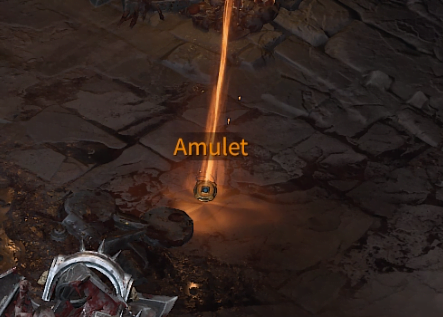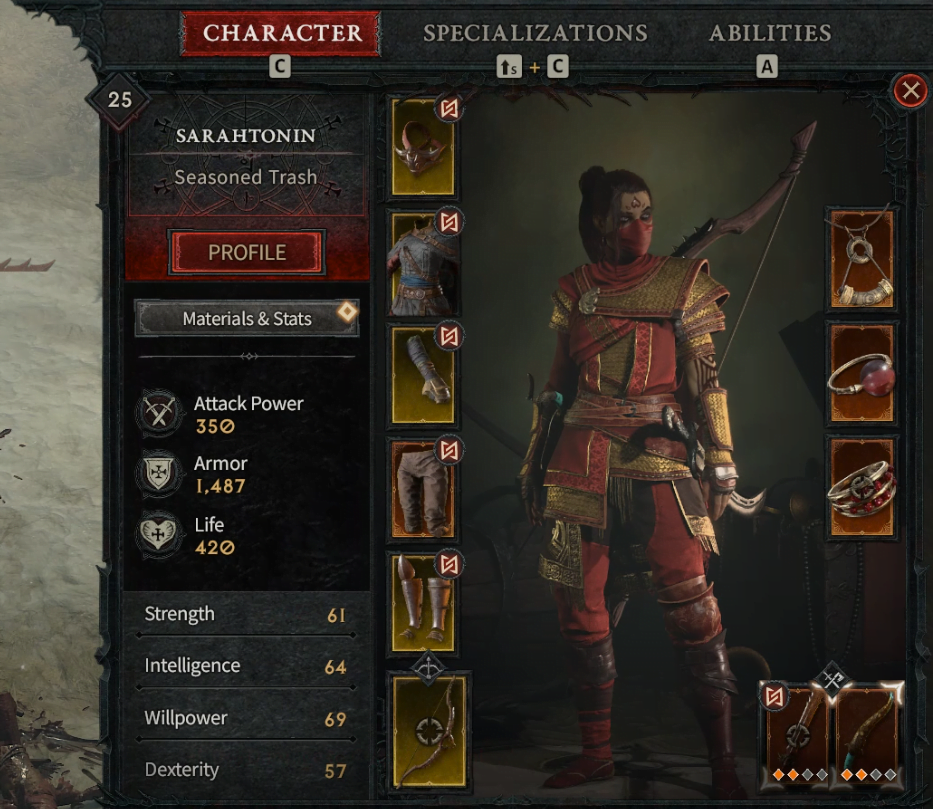Diablo 4 has a lot of keywords, stats, and skills. Explanations for a lot of these stats can be found in various locations in-game, but they aren’t all in one place.
To make things slightly easier to understand, we have compiled this glossary, attempting to explain as many of these keywords as possible. As the game progresses, we will continue to add more to this list, keeping it up to date.
Item Types
Each item in the game is assigned a rarity, dictating the possible stats and effects on that item. A Legendary item isn’t always better than a Rare item, but it has the potential to be.

- Crafting Materials
- Quest Items
- Common
- Magic
- Rare
- Legendary
- Sacred
- Unique
- Ancestral
Enemy Archetypes
Enemies in Diablo 4 are split into several categories to make them easier to distinguish and strategize against.
- Boss
- These are commonly found at the end of Dungeons, typically having multiple phases.
- Bruiser
- Bruisers are larger enemies with high health pools.
- Melee
- Frontline enemies focusing on close-quarters combat.
- Ranged
- Backline enemies focusing on long-range combat.
- Caster
- Mage style enemies, focusing on magical spells and abilities. These are commonly able to debuff with abilities such as Freezes.
- Swarmer
- Quantity over quality. Large amounts of small, easy to kill enemies.
Resources
Each Class has their own unique Resource that function slightly differently from each other.
- Energy – Rogue
- Fury – Barbarian
- Essence – Necromancer
- Spirit – Druid
- Mana – Sorcerer
Sheet Stats
These stats can be found on your Character screen and are primarily used as a quick reference.

- Attack Power
- An evaluation of the damage you deal, based on offensive stats scaled with your currently wielded weapon’s damage and speed.
- Armor
- Reduces Physical Damage taken by %.
- Life
- The total of the Base Life for your Level and any additional bonuses.
- Item Power
- An evaluation of an items combined stats intended to aid in comparing items.
Primary Stats
There are four primary stats available from gear, and these have different bonuses depending on your class. Barbarians for example will get most of their damage from Strength, while Sorcerers will gain their damage from Intelligence.
- Strength
- Increases Resource Generation (Rogue)
- Increases Skill Damage (Barbarian)
- Increases Armor
- Intelligence
- Increases Skill Damage (Sorcerer, Necromancer)
- Increases Critical Strike Chance (Rogue)
- Increases Resource Generation (Druid)
- Increases Resistance to All Elements
- Willpower
- Increases Resource Generation (Barbarian, Sorcerer, Necromancer)
- Increases Skill Damage (Druid)
- Increases Healing Received
- Increases Overpower Damage
- Dexterity
- Increases Critical Strike Chance (Barbarian, Sorcerer, Necromancer, Druid)
- Increases Skill Damage (Rogue)
- Increases Dodge Chance
Keywords
These keywords can be found on most things in the game, everything from gear to skills.
- Vulnerable
- Vulnerable enemies take 20% increased damage.
- Lucky Hit
- Lucky Hit is a type of “chance on hit” mechanic. Different items, skills, passives, and aspects can come with a chance to do something on “Lucky Hit”. Each skill has its own Lucky Hit modifier, for example Invigorating Strike has a 50% Lucky Hit chance, meaning that your Lucky Hit chance is effectively halved with this attack.
- Crowd Controlled
- Enemies that are affected by any of the following effects
- Slowed
- Slowed enemies move at a reduced speed.
- Immobilized
- Immobilized enemies cannot move but are still able to attack and use Skills.
- Stunned
- Stunned enemies are unable to act.
- Knockback
- Knockbacked enemies are forcefully repositioned
- Knockdown
- Knocked down enemies are unable to act.
- Taunt
- Taunted enemies are forced to attack the target that taunted them.
- Fear
- Feared enemies will attempt to run away from player characters.
- Tether
- Tethered enemies are linked together
- Dazed
- Dazed enemies cannot attack or use Skills but are still able to move.
- Chill
- Chilled enemies have reduced Movement Speed. Repeatedly Chilling an enemy will Freeze it.
- Frozen
- Frozen enemies cannot move or attack. Enemies can be Frozen by repeatedly Chilling them.
- Slowed
- Enemies that are affected by any of the following effects
- Unstoppable
- Unstoppable characters have all Control Impairing Effects removed and prevented.
- Fortified
- Fortified characters take 10% reduced damage. You become Fortified when you have more Fortify than current health.
- Overpower
- Overpowering deals bonus damage based on the sum of your current life and Fortified life.
- Berserking
- Berserking grants 25% increased damage and 15% increased Movement Speed. This effect lasts for 5 seconds.
- Barrier
- Barriers absorb damage from all sources.
- Stealth
- Stealthed characters cannot be directly targeted by enemies. Using an attack or taking damage will instantly remove Stealth.
- Crackling Energy
- Crackling Energy periodically damages surrounding enemies when picked up.
- Injured
- Injured characters have less than 35% of their maximum life.
- Healthy
- Healthy characters have more than 80% of their maximum life.
- Distant
- Enemies outside of melee range are considered Distant.
- Close
- Enemies within melee range are considered Close.
- Thorns
- Deals damage to attackers when hit by direct attacks. Excludes attacks that are entirely damage over time. Damage dealt is increased by the Skill Damage increase from your Dexterity.
- Immune
- Immune characters cannot be damaged and all negative effects are removed and prevented.
- Blood Orbs
- Blood Orbs heal you for 15% of your Maximum Life when picked up.
- Armor Contribution
- The inherent percentage that Armor contributes to your base damage reduction against non-Physical attacks.
Skill Types
Each class has three shared skill types, along with several class specific keywords. These keywords are commonly referred to together, for example if an item gives “+1 to Cutthroat Skills”, this will apply to every Skill with that keyword.
General Skill Types
- Basic
- Basic Skills deal damage and are always available to cast.
- Core
- Core Skills spend Resource to deliver powerful attacks.
- Ultimate
- Ultimate Skills shift the tide of battle and devastate your enemies.
Rogue Skill Types
- Cutthroat
- Melee focused attacks.
- Marksman
- Ranged focused attacks.
- Agility
- Agility Skills maneuver you across the battlefield with adept mobility.
- Imbueable
- Imbuement Skills infuse attacks with potent Elemental effects.
- Trap
- Abilities that are placed on the ground, activating once an enemy steps on them.
- Subterfuge
- Subterfuge Skills outwit and debilitate enemies with trickery.
- Grenade
- Thrown area-of-effect skills.
Barbarian Skill Types
- Dual Wield
- Abilities using your one-handed weapons.
- Bludgeoning
- Abilities using your blunt weapon.
- Slashing
- Abilities using your slashing weapon.
- Channeled
- Abilities that continue as long as you hold the hotkey and have resources.
- Defensive
- Defensive Skills mitigate damage received and increase survivability.
- Shout
- Area-of-Effect buff and debuff skills castable while channeling.
- Brawling
- Brawling Skills reposition you or boost damage during a fight.
- Weapon Mastery
- Weapon Mastery Skills unleash powerful attacks that alter the battle.
Sorcerer Skill Types
- Pyromancy
- Spells focused on Fire damage.
- Shock
- Spells focused on Lightning damage.
- Frost
- Spells focused on Cold damage.
- Channeled
- Abilities that continue as long as you hold the hotkey and have resources.
- Defensive
- Defensive Skills mitigate damage received and increase survivability.
- Conjuration
- Conjuration Skills summon Elemental entities to aid in battle.
- Mastery
- Mastery skills spend Mana to dominate the battlefield
Necromancer Skill Types
- Blood
- Spells focused on draining and restoring Life.
- Bone
- Spells focused on Physical damage and Critical Hits.
- Darkness
- Spells focused on Shadow damage and Damage Over Time.
- Channeled
- Abilities that continue as long as you hold the hotkey and have resources.
- Macabre
- Macabre Skills control the battlefield and manipulate the deceased.
- Corpse
- Corpse Skills control the battlefield and manipulate the deceased.
- Corruption
- Spells focused on desecrating corpses.
- Curse
- Curse Skills afflict debilitating effects upon your foes.
- Summoning
- Abilities that summon Undead Minions.
Druid Skill Types
- Nature Magic
- Spells invoking various elements.
- Earth
- Spells focused on Physical damage and Crowd Control.
- Storm
- Spells focused on Lightning damage.
- Werewolf
- Abilities focused on Offensive Shapeshifting.
- Werebear
- Abilities focused on Defensive Shapeshifting.
- Shapeshifting
- Abilities that change your form.
- Channeled
- Abilities that continue as long as you hold the hotkey and have resources.
- Defensive
- Defensive Skills mitigate damage received and increase survivability.
- Companion
- Companion Skills summon allies from nature to aid you in battle.
- Wrath
- Wrath Skills unleash powerful effects that alter the battle.